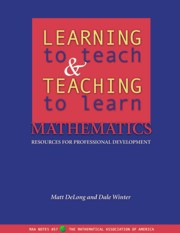Book contents
- Frontmatter
- Preface
- Contents
- 1 The Professional Development Program
- 2 How to Use this Book
- 3 An Orientation Session for the Beginning of the Semester
- 4 Making In-class Groups Work
- 5 Getting Students to Read the Textbook
- 6 Assessing and Evaluating Students' Work
- 7 Managing Homework Teams
- 8 Teaching During Office Hours
- 9 Establishing and Maintaining Control in Your Classroom
- 10 Proctoring Tests and Examinations
- 11 Teaching with Calculators and Computers
- 12 Making Lesson Plans
- 13 Strategies for Motivating Students
- 14 Dealing With Difficult Instructor-Student Situations
- 15 End-of-Semester Administration
- 16 Adapting Materials and Designing Your Own Meetings
- 17 Classroom Visits
- A Tips for Running Meetings
- B The Michigan Introductory Program
- Bibliography
12 - Making Lesson Plans
- Frontmatter
- Preface
- Contents
- 1 The Professional Development Program
- 2 How to Use this Book
- 3 An Orientation Session for the Beginning of the Semester
- 4 Making In-class Groups Work
- 5 Getting Students to Read the Textbook
- 6 Assessing and Evaluating Students' Work
- 7 Managing Homework Teams
- 8 Teaching During Office Hours
- 9 Establishing and Maintaining Control in Your Classroom
- 10 Proctoring Tests and Examinations
- 11 Teaching with Calculators and Computers
- 12 Making Lesson Plans
- 13 Strategies for Motivating Students
- 14 Dealing With Difficult Instructor-Student Situations
- 15 End-of-Semester Administration
- 16 Adapting Materials and Designing Your Own Meetings
- 17 Classroom Visits
- A Tips for Running Meetings
- B The Michigan Introductory Program
- Bibliography
Summary
An obvious skill that needs to be acquired by new instructors is the ability to plan an effective lesson. In a course consisting primarily of lectures, this translates into writing clear and engaging lectures that include ways of assessing the lectures' effectiveness. There has been much written on the art of preparing such lectures. On the other hand, in an interactive student-centered course, planning an effective lesson translates into a very different activity. The instructor must decide how to balance the various teaching methodologies at his or her disposal so as to achieve the different learning goals set forth for that session. Allowing for a combination of approaches provides the opportunity for a richer learning environment, but it also demands additional considerations such as which methodologies to employ in different parts of a class, how to manage the different activities planned, and how to develop connections among the activities into a coherent lesson.
One criticism that advocates of a purely lecture course make of student-centered courses is that students might actually spend less time out of class engaged in the material as a result of having engaged in active learning in the classroom. In fact, we do not assume that our students are working less outside of class merely because they are working differently inside of class. Instead, the model advocated here requires the students to read the material before coming to class for an initial level of understanding (see Chapter 5).
- Type
- Chapter
- Information
- Learning to Teach and Teaching to Learn MathematicsResources for Professional Development, pp. 149 - 158Publisher: Mathematical Association of AmericaPrint publication year: 2002

